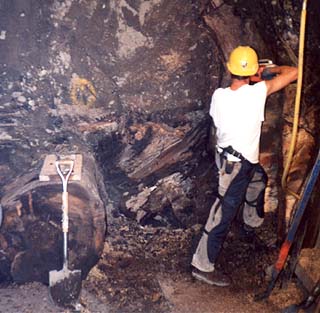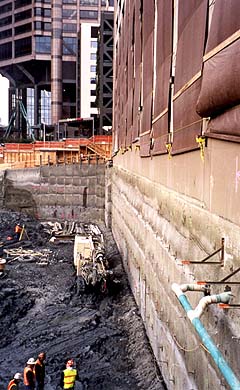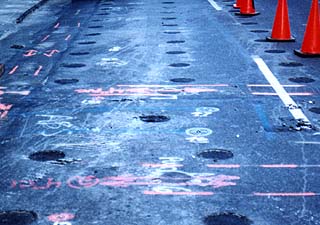|
Subscribe / Renew |
|
|
Contact Us |
|
| ► Subscribe to our Free Weekly Newsletter | |
| home | Welcome, sign in or click here to subscribe. | login |
Construction
| |
 |
October 31, 2002
Engineers had their fill of this site
Shannon & Wilson

Courtesy of Shannon & Wilson A skid road running under James Street toward Elliott Bay was discovered during the excavation. To complete a pedestrian tunnel to the King County Jail, the thick logs that formed the skid had to be cut away. |
The foundations and excavations for the Seattle Justice Center presented challenges to the geotechnical engineers. Two areas in particular — the pedestrian tunnel connecting the new building with the King County Jail and the 30 to 40-foot deep shored excavation directly adjacent to the parking garage at Sixth Avenue and Cherry Street — provided unique difficulties.
The tunnel
Running 24 to 32 feet beneath James Street, the horseshoe-shaped pedestrian tunnel is 10 feet wide and 12 feet high. Borings discovered nearly 30 feet of loose sand fill beneath James Street, and encountered groundwater above the invert. Considering these ground conditions, the risk of settlement and impact to water, gas and deep old sewer lines was significant. Ground improvement was required.
The soils were stabilized above and next to the tunnel excavation with cement grout. Over 250 cubic yards of grout were injected into the soil through 99 separate grout pipes beneath the street. So successful were these soil improvements that settlement of the street and utilities during tunneling was negligible.
Another complication was the discovery of a skid road running directly beneath James Street. Logs formed a skid to sluice cut timber down First Hill to Elliott Bay. Urban sites are always full of subsurface utilities: vaults and pipes are anticipated obstacles, and an experienced design team has ready solutions. A trough of logs 3 to 4 feet in diameter, however, is a not-so-common occurrence. Construction of the tunnel involved chopping and sawing through the logs before placing steel ribs and lagging.
Foundations
The parking garage at Sixth and Cherry is supported on augercast piles. At some locations, only 15 feet of pile remained below the bottom of the Justice Center excavation. To maintain soil confinement — and hence soil friction and pile capacity — the excavation next to the garage was restrained with a series of prestressed nails and a shotcrete facing. Nails were stressed to 20 kips and spaced between each pile at a 5-foot spacing.

Courtesy of Shannon & Wilson The excavation, which abutted a parking garage, was restrained with a series of prestressed nails and a shotcrete facing. The system proved less expensive than using soldier piles and tiebacks. |
Monitoring indicated that with this system the garage did not move during the excavation process. In addition, a significant amount of money was saved by using the prestressed soil nail system instead of a costly conventional soldier piles and tiebacks.
On the north side (Cherry Street), shoring consisted of a few prestressed tiebacks restraining an existing basement/retaining wall, soil nail walls with shotcrete and a series of vertical mini soldier piles restrained with prestressed soil nails.
The mini piles were needed to cantilever next to a large electrical vault. Soils along Cherry Street consisted of hard clay with local fracture zones that was stabilized with soil nails. Again, monitoring indicated the excavation moved less than half an inch. On the south side (James Street), soil conditions consisted of loose sand fill and groundwater in the east corner, at Sixth Avenue. A conventional soldier pile tieback system was used successfully at this location.
The foundation systems supporting the Justice Center are innovative, consisting of three large mats and a series of drilled piers. To avoid overstressing the existing piles, the mats are set back from the garage.
A series of heavy columns located within a few feet of the garage further complicated the foundation design. As with mats, to avoid overloading the piles, drilled piers were used to transfer vertical loads from the heavy columns.
The combined mats/drilled piers were far more cost-effective than supporting the entire Justice Center on belled drilled piers, which was originally proposed.
LEED contribution
While cost-effective in developing solutions to the challenges and innovations in foundation design, the geotechnical design also supported the team’s objectives in obtaining a U.S. Green Building Council LEED silver rating.

Courtesy of Shannon & Wilson Over 250 cubic yards of grout were injected into the soil through 99 separate grout pipes beneath the street. The pipes helped stabilize loose soil during construction of the pedestrian tunnel.
|
The success of the LEED certification process depends on an integrated team approach. While many of the credits available relate directly to the design of the architect and the building systems engineers, all design team members can make credit-worthy contributions. Geotechnical firms can contribute by helping to create a sustainable site and enhance water and materials efficiency.
To create a sustainable site, geotechnical firms can assist with site selection, urban and brownfield redevelopment, site-disturbance reduction and stormwater management.
Collecting groundwater from subslab drainage systems and recycling it for nonpotable water systems is an innovation worthy of water-efficiency credits. With an eye toward materials efficiency, the geotechnical engineer can reuse and recycle materials and resources.
On the Seattle Justice Center project, the geotechnical design involved both recycling and reuse. Recycled concrete was used as structural fill. An existing retaining wall along Cherry Street was reused for shoring.
Sustainable design practices resulting in LEED certification need not be expensive. Fast-track, cost-effective geotechnical solutions can be an integral part of a LEED-certifiable design.
Tom Gurtowski is a vice president at Shannon & Wilson, a nationally recognized consulting firm dedicated to providing a full range of geotechnical, environmental and natural resource services.
Other Stories:
- A model for sustainable design
- Architectural odd couple is bound by public spirit
- Plaza helps unify civic campus
- Sustainability comes with a view
- Justice Center art reflects social themes


